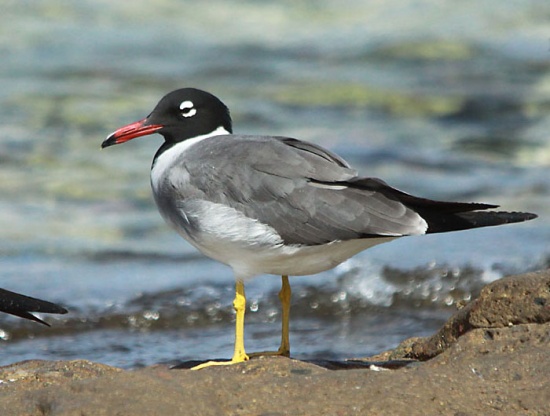- Ichthyaetus leucophthalmus
Larus leucophthalmus
Identification
Length 39–45 cm (15¼-17¾ in), wingspan 105–113 cm, weight 275–415 g
Adult: Black hood with conspicuous white eye crescents in breeding plumage, black upper throat, and neck-sides, bordered below by a narrow white bar. Dark grey upperparts and inner upperwings, mid-grey breast, white underparts. Black primaries, black secondaries with a white trailing edge, dark underwing; tail white.
Bill very long and strikingly slender, deep red with a black tip; legs yellow.
Adults in non-breeding plumage are similar, but the hood is flecked with small white spots.
Juvenile: chocolate brown head, neck and breast, brown, broadly pale-fringed, feathers to upperparts and upperwings, black tail, black bill. Greyer feathering on their head, breast and upperparts appear during the first winter; second-winter plumage is closer to that of the adult, but lacking the hood.
Adult plumage is acquired at two to three years of age.
Similar Species
Sooty Gull is closely related and occurs in the same area; it differs in being larger and stouter, and browner above; it has a heavy bill with a yellow base and small red tip (pale grey with a black tip in immatures).
Distribution
Restricted to the coasts of the Red Sea in Israel (Eilat only), Jordan (Aqaba only), Egypt, Sudan, Eritrea, Djibouti, Saudi Arabia, Yemen and Somalia; regular east to Socotra.
Very rare vagrant to the Mediterranean coast of Israel (3 records), the United Arab Emirates (3 records), and south to Kenya (1 record) and the Maldives. Two historical (19th century) records from Greece are supported by museum specimens.
Taxonomy
This is a monotypic species[1].
Like the other species in its genus, it was formerly included in the genus Larus.
Habitat
Inshore islands with rocks and sandy beaches.
Status
Classified as Near Threatened in the 2008 IUCN Red List.2
Behaviour
Diet
Their diet consists mostly of fish, crustaceans, molluscs, annelids and offal. They also eat some fruit.
Breeding
They make a shallow scrape nest, lined with seaweed and debris, located on bare rock, sand or exposed flats. The clutch contains 2-3 eggs. They have a single brood, but may try again if the first clutch is lost.
References
- Clements, J. F., T. S. Schulenberg, M. J. Iliff, D. Roberson, T. A. Fredericks, B. L. Sullivan, and C. L. Wood. 2018. The eBird/Clements checklist of birds of the world: v2018. Downloaded from http://www.birds.cornell.edu/clementschecklist/download/
- BirdLife International (2008) Species factsheet: Larus leucophthalmus. Downloaded from http://www.birdlife.org on 12/9/2008.
- Burger, J., Gochfeld, M., Kirwan, G.M. & Garcia, E.F.J. (2019). White-eyed Gull (Larus leucophthalmus). In: del Hoyo, J., Elliott, A., Sargatal, J., Christie, D.A. & de Juana, E. (eds.). Handbook of the Birds of the World Alive. Lynx Edicions, Barcelona. (retrieved from https://www.hbw.com/node/53968 on 1 August 2019).
Recommended Citation
- BirdForum Opus contributors. (2025) White-eyed Gull. In: BirdForum, the forum for wild birds and birding. Retrieved 30 April 2025 from https://www.birdforum.net/opus/White-eyed_Gull
External Links
GSearch checked for 2020 platform.






